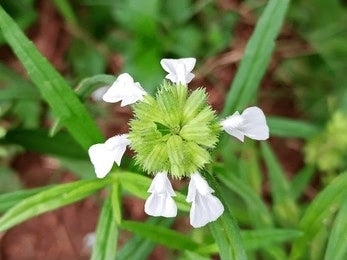Leucas cephalotes, also known as dronapushpi, is an annual plant that reaches a height of 15 to 60 cm. The leaves are slender, oval, yellowish-green in color, and between 3 and 9 cm long and 1 to 2.5 cm wide. Roots are smooth, cylindrical, zigzag-shaped, and have a variety of wiry, fine rootlets of varying sizes that are fibrous and have a mild flavor. The stem has a quadrangular shape, a rough, hairy surface, a bright greenish-yellow color, and a slightly bitter flavor. White, sessile, tiny flowers grow in many axillary whorls. Schizocarpic carcerule fruits with 3mm smooth, brown nutlets.
General Description
In India and several Southeast Asian nations, the Ayurvedic herb dronapushpi (Leucas cephalotes) thrives as a weed. It is grown as a weed in fields, especially following a spell of rain. In addition to its medical benefits, it is harvested for use as a leafy vegetable in rural areas. This herb is typically used to cure conditions including fever, coughing up blood, scorpion stings, and snake bites. Additionally, it is used to treat liver conditions, jaundice, asthma, cough, colds, etc. It is a medicinal herb with antibacterial, insecticidal, fever-reducing, larvicidal, and anti-inflammatory properties. Leucas aspera is a species that is known as Dronapushpi.
This herb's chemical composition includes Laballenic acid, B- Sitosterol and its glycoside, oleanolic acid, 7-oxositosterol, 7-oxostigmasterol, 7alpha-hydroxy stigmasterol, stigmasterol, 5-hydroxy-7,4'-dimethoxy flavone, pillion, gonzalitosin I, Tricin, cosmosin, apigenin-7-O-beta-D-(6-O-p-coumaryl) glucopyranoside, anisofolin A and luteolin.
Classification
- Kingdom: Plantae, Plant
- Subkingdom: Tracheobionta, Vascular plant
- Super division: Spermatophyta, Seed plant
- Division: Angiosperma
- Class: Dicotyledonae
- Sub-class: Gamopetalae
- Series: Bicarpellatae
- Order: Tubiflorae
- Family: Labiatae
- Genus: Leucas
- Species: Leucas Cephalotes
Habitat
This plant is widely distributed throughout China and India. It is particularly common as a weed in cultivated fields, by the sides of roads, and on wastelands throughout India, where it grows up to 1,800 meters in the Himalayas. The plains of Bangladesh, South-East Asian nations, Mauritius, Java, the Philippines, China, and Malaysia are also home to Leucas cephalotes. It is also frequently found in Nepal, Pakistan, and East Asia at elevations between Western China and Afghanistan of 1,700 meters.
Other Names
- English Name - Spider wort
- Hindi Name - Guma
- Telugu Name - Tummi, Peddatumani
- Bengali Name - Dandakalas, Halaksa, Ghalghase
- Marathi Name - Tubari, Tumba
- Gujarati Name - Kubo
- Punjabi Name - Gomobati, Gumma
- Tamil Name - Tumbari
- Kannada Name – Tumbe, Tumbe hoovu, Tumbe gida
- Malayalam Name – Tumba, Tumba Poovu
- Sanskrit Name - Katumba
- Oriya Name - Gaisha
- Assamese Name - Dronaphool
Ayurvedic Properties
|
Particular |
Hindi / Sanskrit |
English |
|
Rasa (Taste) |
Katu |
Pungent |
|
Guna (Physical Property) |
Guru, Rooksha |
Heavy, Dry |
|
Virya (Potency) |
Ushna |
Hot |
|
Vipaka (Post-Digestive Taste) |
Katu, Madhura |
Pungent, Sweet |
Effect on Dosha
Dronapushpi can balance Kapha and Vata.
Practical Uses
In addition to being anthelmintic, antiseptic, insecticidal, anti-scabies, anticoagulant, antipyretic, stimulant, expectorant, diaphoretic, insecticidal, emmenagogue, antioxidant, anti-inflammatory, and anti-diabetic, this herbal plant also has other beneficial properties. Hypotensive, cardiodepressant, and exhibiting strong anti-filarial efficacy against adult worms and microfilaria.
- It helps treat conditions of the skin including psoriasis, scabies, and itching. The damaged bodily parts receive external application of the leaf paste.
- This plant's juice has reportedly been used as a natural jaundice treatment.
- It is helpful for infected wounds and worm infestations.
- It has anti-inflammatory properties, which aid in lowering swelling.
- Relieve from asthma, a cough, and a cold.
- This herb improves flavor and aids in the treatment of anorexia.
- The herb decoction as a wash liquid is beneficial in ulcers and can also be administered externally to harmful bug bites.
- Good for indigestion and low digestive strength.
- Suitable for amenorrhea and oligomenorrhea.
- Because it is scraping in nature, it can scrape the sputum out.
- Dronapushpi has been shown to test positive for filariasis.
- The whole plant powder is used to treat epileptic seizures and cognitive function impairments.
- It can also help with colic, dyspepsia, and arthralgia.
- The Dronapushpi plant has the ability to eliminate toxins from the body.
Part Used
- Whole Plant,
- Leaves,
- Flowers
Dosage
Fresh juice: 5 -10 ml juice
Powder for decoction: 1–3g
Caution
- This herb's overuse or overdosage may result in an intensified burning sensation.
- During pregnancy, avoid it. It is advised to utilize this plant with appropriate medical supervision.

